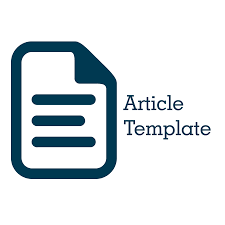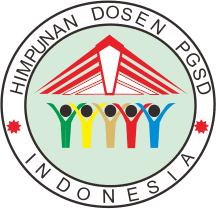Pengaruh penerapan model pembelajaran project based learning berbantuan augmented reality terhadap kemampuan berpikir kritis peserta didik kelas VI materi tata surya
Abstract
The purpose of this research is to determine if sixth graders at SDN 1 Sedayu can improve their solar system-related critical thinking abilities by using an AR-augmented project-based learning (PjBL) paradigm. Both the control and experimental groups' pre- and post-test scores increased significantly. A post-test average of 79.61 was achieved by the experimental class, whose average pre-test score was 56.92, while a post-test average of 60.27 was achieved by the control class, whose average pre-test score was 50.31. The data were first examined for normality and homogeneity using the Kolmogorov-Smirnov and Levene tests, which confirmed that the samples were distributed normally and were similar to one another. Only then were hypothesis testing initiated. After doing hypothesis testing using a paired sample t-test, the null hypothesis (H0) was rejected due to a significance value of 0.00, which is less than 0.05. These findings demonstrate a notable difference between the two groups and demonstrate that students' critical thinking abilities are improved with the use of AR-assisted PjBL. Consistent with other findings, this study confirms that PjBL and AR effectively boost students' motivation, engagement, and critical thinking abilities.
Keywords
References
Ayu, A., Amri, U., & Mustika, J. (2022). FRISCO Criteria: Analysis of Student’s Mathematic Critical Thinking Ability on HOTS Test. International Conference on Language, Linguistics, Literature and Education (ICLLLE). Azuma, R. T. (1997). A Survey of Augmented Reality. Presence: Teleoperators and Virtual Environments, 6(4), 355–385. https://doi.org/10.1162/pres.1997.6.4.355 Dewey, J. (1986). Experience and Education. The Educational Forum, 50(3), 241–252. https://doi.org/10.1080/00131728609335764 Ennis, R. H. (1987). CRITICAL THINKING AND THE CURRICULUM. In M. Heiman & J. Slomianko (Eds.), Thinking Skills Instruction: Concepts and Techniques (Vol. 72, pp. 40–48). A National Education Association Publication. Facione, P. A., & Facione, N. C. (2013). Critical Thinking for Life. Inquiry: Critical Thinking Across the Disciplines, 28(1), 5–25. https://doi.org/10.5840/inquiryct20132812 Fahtussyakir, M. (2018). Penerapan Model Pembelajaran Berbasis Proyek untuk Meningkatkan Aktivitas dan Prestasi Belajar Penerapan Rangkaian Elektronika Siswa Kelas XI TAV 1 SMKN 2 Kota Bima Pokok Bahasan Merencanakan Rangkaian Filter Tahun Pelajaran 2017/2018. JISIP (Jurnal Ilmu Sosial Dan Pendidikan), 2(1), 245–253. https://doi.org/10.58258/jisip.v2i1.318 Feng Zhou, Duh, H. B.-L., & Billinghurst, M. (2008). Trends in augmented reality tracking, interaction and display: A review of ten years of ISMAR. 2008 7th IEEE/ACM International Symposium on Mixed and Augmented Reality, 193–202. https://doi.org/10.1109/ISMAR.2008.4637362 Herzon, H. H., Budjianto, & Utomo, D. H. (2017). Pengaruh Problem-Based Learning (PBL) terhadap Keterampilan Berpikir Kritis. Jurnal Pendidikan, 3(1), 42–46. http://journal.um.ac.id/index.php/jptpp/ Kemendikbud. (2017). Panduan Penilaian oleh Pendidik dan Satuan Pendidikan Sekolah Menengah Pertama Cetakan Keempat, 2017 Milik Negara Tidak diPerdagaNgkaN Penulis Tim Direktorat Pembinaan SMP desain Visual MS Lubis Sumber ilustrasi. http://ditpsmp.kemdikbud.go.id Lidiawati, K. R., & Aurelia, T. (2023). Kemampuan Berpikir Kritis Siswa di Indonesia: Rendah atau Tinggi? Konsorium Psikologi Ilmiah Nusantara, 9(2). Mills, G. E., & Gay, L. R. (2018). Education research: Competencies for analysis and applications. Journal of Applied Learning & Teaching, 1(2), 71–72. http://journals.sfu.ca/jalt/index.php/jalt/index Mulyasa, Iskandar, D., & Aryani, W. D. (2017). Revolusi dan inovasi pembelajaran : Sesuai standar proses (Cetakan 2). Pt Remaja Rosdakarya. Mustaqim, I. (2016). PEMANFAATAN AUGMENTED REALITY SEBAGAI MEDIA PEMBELAJARAN. Jurnal Pendidikan Teknologi Dan Kejuruan, 13(2), 174. Novitasari, Y., & Fauziddin, M. (2022). Analisis Literasi Digital Tenaga Pendidik pada Pendidikan Anak Usia Dini. Jurnal Obsesi : Jurnal Pendidikan Anak Usia Dini, 6(4), 3570–3577. https://doi.org/10.31004/obsesi.v6i4.2333 Paul, R., & Elder, L. (2006). Critical Thinking: The Nature of Critical and Creative Thought. In Journal of Developmental Education (Vol. 30, Issue 2). Pendidikan, M., Kebudayaan, D. A. N., & Indonesia, R. (2016). Peraturan Menteri Pendidikan Dan Kebudayaan Nomor 22 Tahun 2016 Tentang Standar Proses Pendidikan Dasar Dan Menengah. Piekarski, W., & Thomas, B. H. (2002). Tinmith-Metro: new outdoor techniques for creating city models with an augmented reality wearable computer. Proceedings Fifth International Symposium on Wearable Computers, 31–38. https://doi.org/10.1109/ISWC.2001.962093 Rahmawati, U., & Firda Salimah, K. (2024). AUGMENTED REALITY PADA PEMBELAJARAN IPA BERBASIS PROYEK UNTUK MENGEMBANGKAN CRITICAL THINKING SISWA SMP. Sholikhah, U. P., Rahmawati, N. D., Muhtarom, & Purwantini, L. (2023). IMPLEMENTASI MODEL PROBLEM BASED LEARNING DENGAN MEDIA AUGMENTED REALITY TERHADAP HASIL BELAJAR SISWA . Jurnal Eksponen, 13(2), 57–65. https://doi.org/10.47637/eksponen.v13i2.777 Sumarni, W. (2013). The Strengths and Weaknesses of the Implementation of Project Based Learning: A Review. In International Journal of Science and Research (Vol. 4). www.ijsr.net Wahyu, R. (2016). Implementasi Model Project Based Learning (PJBL) Ditinjau dari Penerapan Kurikulum 2013. Teknoscienza , 1(1), 49–62. Wati, E. Sujar. M. Rahmah. N. S. (2023). Upaya peningkatan hasil belajar dengan menerapkan model Project Based Learning melalui media Augmented Reality. Nautical : Jurnal Ilmiah Multidisiplin , 2.
Refbacks
- There are currently no refbacks.



